So, what then do we make of Jews for Baby Jesus? You know — those members of the Tribe of Judah who have written and recorded some of the world’s most beloved songs celebrating the season of Christ’s birth. Irving Berlin composed “White Christmas.” Jews Ray Evans and Jay Livingston (born Jacob Harold Levison) wrote “Silver Bells.” Christmas-crazy Jew Johnny Marks penned such classics as “Rudolph the Red-Nosed Reindeer,” “Rockin’ Around the Christmas Tree,” “A Holly Jolly Christmas,” and “Run Rudolph Run.” Let’s face it, Jews write some pretty catchy tunes. If George and Ira Gershwin can realistically portray a slice of African American life by writing “Porgy and Bess,” then Mel Tormé (surprise! a Jew!) can give us that somewhat unrealistic Ozzie and Harriet image of happy Christians “roasting chestnuts on an open fire.”
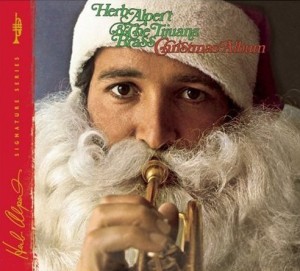 And admit it — how many times have you thrown a yule log on the fire, cranked up the Hi-Fi, and noshed on lox and cream cheese while enjoying a Christmas record by Barbra Steisand, Neil Diamond, Herb Alpert, Bette Midler or Barry Manilow? Even America’s most revered punk rocker, the late Joey Ramone (a Jew born Jeffrey Ross Hyman) – famous for his little ditties about sniffing glue and beating on brats with baseball bats – revealed his gentler side when he composed “Merry Christmas (I Don’t Want to Fight Tonight.)” Hey, Ho, Let’s Go – Ho, Ho, Ho!
And admit it — how many times have you thrown a yule log on the fire, cranked up the Hi-Fi, and noshed on lox and cream cheese while enjoying a Christmas record by Barbra Steisand, Neil Diamond, Herb Alpert, Bette Midler or Barry Manilow? Even America’s most revered punk rocker, the late Joey Ramone (a Jew born Jeffrey Ross Hyman) – famous for his little ditties about sniffing glue and beating on brats with baseball bats – revealed his gentler side when he composed “Merry Christmas (I Don’t Want to Fight Tonight.)” Hey, Ho, Let’s Go – Ho, Ho, Ho!
But, in the words of Jewish vaudeville sensation Al Jolson, when it comes to Jews crooning carols, “You ain’t heard nothin’ yet!” The distinct nasal droning of rock’s premier poet, Bob (Zimmerman) Dylan, will be blowin’ in the Christmas wind when I crank up his 2009 album, “Christmas in the Heart.” Now I admit, I don’t listen to a single holiday song on any of my Apple devices, unless it’s one of those rare, reality-based gritty urban tunes like The Pogues’ “Fairytale of New York” (It was Christmas eve, babe / In the drunk tank / An old man said to me: won’t see another one…). I’ve even been known to cut short my visits to Macy’s shoe department when “sleigh bells jingling” start to ring-ting-tingle my brain.
But Bob Dylan singing Christmas carols? Lords a-leapin’ – that’s a whole ‘nother story! I mean, do you hear what I hear?
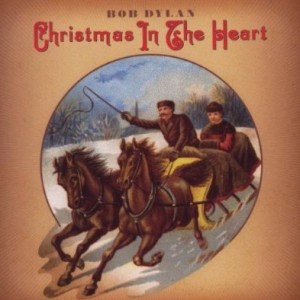 I think Jesus listens to Bob’s music all the time. Heck, their back pages are so similar. Bob, like Jesus, is a Jew. Like Jesus, he was considered by many to be the Messiah of their generation. They both spoke in mystical ways and were often misunderstood. Like Jesus, Bob toured the region and had groupies. Like Jesus, he was persecuted by his own people – in Bob’s case, by the folkies who felt he sold out by “going electric.” Of course, that’s where the similarities end. This is called satire, people. Don’t get your knickers in a twist. I am NOT implying that Bob Dylan is Christ-like, or even that he’s bigger than Christ. We all know how that remark almost cost John Lennon his life at the hands of those hatin’, cross-burning Christian KKK guys.
I think Jesus listens to Bob’s music all the time. Heck, their back pages are so similar. Bob, like Jesus, is a Jew. Like Jesus, he was considered by many to be the Messiah of their generation. They both spoke in mystical ways and were often misunderstood. Like Jesus, Bob toured the region and had groupies. Like Jesus, he was persecuted by his own people – in Bob’s case, by the folkies who felt he sold out by “going electric.” Of course, that’s where the similarities end. This is called satire, people. Don’t get your knickers in a twist. I am NOT implying that Bob Dylan is Christ-like, or even that he’s bigger than Christ. We all know how that remark almost cost John Lennon his life at the hands of those hatin’, cross-burning Christian KKK guys.
Unlike other Jews who write and sing about Christmas, however, Bob had at least some actual experience with the New Testament. I guess you don’t have to be born a Christian to become “born again.” And that’s exactly what Mr. Dylan did in the late 1970s. A messy divorce, coupled with the ill effects of non-stop touring, notorious womanizing and excessive drinking led him to seek shelter from the storm. And he found it, in the form of Jesus. He once said, “There was a presence in the room that couldn’t have been anybody but Jesus. I truly had a born-again experience, if you want to call it that…. It was a physical thing. I felt it all over me. I felt my whole body tremble.”
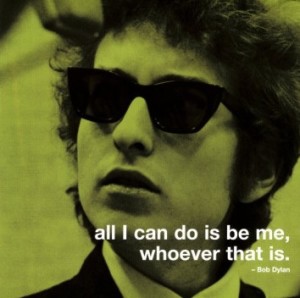
His conversion to Christianity outraged many, but Bob was never one to cater to the expectations of fans or peers. He released two Christian albums – “Slow Train Coming” in 1979 and “Saved” in 1980. While recording the former LP, he tried to convert record producer Jerry Wexler to Christianity, to which Jerry replied, “Bob, you’re dealing with a sixty-two-year old Jewish atheist. Let’s just make an album.” But Bob was truly on a mission. During his 1979 tour, he preached to the audience: “I told you the answer was ‘Blowin’ In The Wind’ and it was! And I’m saying to you now, Jesus is coming back and he is! There is no other way to salvation…Jesus is coming back to set up his kingdom in Jerusalem for a thousand years.” Wow, was Bobby still dropping acid at that time?
Well, thankfully, Mr. Dylan eventually tired of all this proselytizing, and became….well, one of his myriad “old selves” again (he’s a Gemini, you know). After many years, he reconnected with his Jewish roots, even visiting the Wailing Wall in Jerusalem on the day of his son’s bar mitzvah in 1983. He’s long been a supporter of the Chabad Lubavitch movement and once appeared on a Chabad telethon.
But even though he’s no longer a full-time Christian, he believes that Christmas tunes are an integral part of America’s rich folk song tradition. When former Musician magazine editor Bill Flanagan told Dylan during a November 2009 interview that he delivered “O Little Town of Bethlehem” like “a true believer,” Bobby replied, “Well, I am a true believer.”
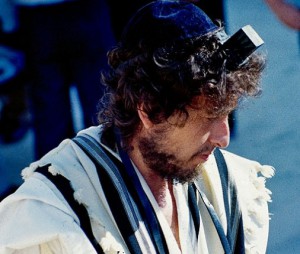 So, if you’re a fan of Bob Dylan – no matter what your faith or lack thereof – give his “Christmas in the Heart” album a go. The record received favorable reviews, with many critics praising the sincerity with which he performs the songs. Royalties from the sale of the CD benefit a number of charities: Feeding America in the USA, Crisis in the UK, and the World Food Programme.
So, if you’re a fan of Bob Dylan – no matter what your faith or lack thereof – give his “Christmas in the Heart” album a go. The record received favorable reviews, with many critics praising the sincerity with which he performs the songs. Royalties from the sale of the CD benefit a number of charities: Feeding America in the USA, Crisis in the UK, and the World Food Programme.
I only wish he had written one original holiday tune for his album. But since he didn’t, I’ve taken the liberty of penning Christmasy lyrics to one of Bob’s most interesting and acerbic songs: “Ballad of a Thin Man,” from the 1965 album that changed my life, “Highway 61 Revisited.”
“Ballad of a Fat Man”
You crawl out of the chimney
With a toy sack in your hand,
You see somebody passed out
And you say, “Who is that man?”
You try so hard
But you don’t understand,
Just what went on
In this guy’s home.
Because something is happening here
But you don’t know what it is.
Do you, Mr. Claus?
You shake off the soot,
And you ask, “Why did you drink?”
And the guy points to his wife and says,
“Whaddya think?”
And she sits on the couch and says,
“I poured the rest down the sink.”
And you say, “Oh my God,
Another reveler stoned!”
But you know something is happening here
But you just don’t know what it is.
Do you, Mr. Claus?
You hand out the presents,
And you sneer at the slob,
Who sobers up and realizes
You’re not there to rob.
And he says “How does it feel
To be such a blob?”
And you say, “Heathen!”
As you hand him some coal.
And something is happening here
But you just don’t know what it is.
Do you, Mr. Claus?
You have many contacts
Among the North Pole hacks
To get you facts
When some non-believer attacks your reputation.
But some people have little respect.
Anyway they still expect you
To give gifts to those who run despicable organizations.
You’ve been with the Easter Bunny.
And he’s laughed at your looks.
With great cherubim and seraphim
You’ve discussed atheists and kooks.
You’ve been through all of Dr. Stillman’s diet books,
You’ve very well read,
It’s quite known.
But something is happening here,
But you just don’t know what it is.
Do you, Mr. Claus?
Well, the reindeer, they come up to you
And they ask “How?”
They’ll haul your ass ’round the world
But you’re as big as a sow.
And you say, “Put these reins on,
or I’ll eat you as chow.”
And they say, “Drive that sleigh yourself,
We’re going home.”
And you know something is happening here
But you don’t know what it is.
Do you, Mr. Claus?
Now, here’s a rollicking version of Bob’s “Must Be Santa” – Klezmer style. It’s one of the most wonderfully wacky videos I’ve ever seen. Unlike the original, he inserts the names of eight U.S. presidents when he reads off the reindeer names: “Dasher, Dancer, Prancer, Vixen / Eisenhower, Kennedy, Johnson, Nixon / Dasher, Dancer, Prancer, Vixen / Carter, Reagan, Bush and Clinton.” The young man who jumps out the window at the end is rumored to be Bob’s son.
By Dana Spiardi, Dec 19, 2013
]]>
Being swept off the street by a rock star may be nothing more than a wet dream for yer blogger, but this really did happen to a young violinist named Donna Shea, better known as Scarlet Rivera.
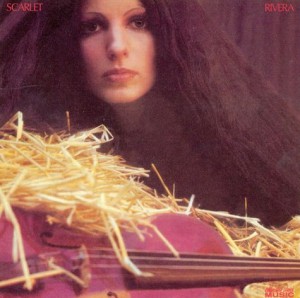 One summer day in 1975, Ms. Rivera, violin case in tow, set out from her apartment in New York’s bare-knuckle Lower East Side, erstwhile home of your huddled masses. She was headed to a friend’s house to kill some time prior to a rehearsal with a long-forgotten Latin band. All of a sudden a car cuts her off at an intersection, a woman leans her head out the window, and asks her if she really can play the violin. Scarlet peers into the car and spies none other than Napoleon in Rags himself – Bob Dylan – in the driver’s seat. Bobby ordered his companion, percussionist Sheena Seidenberg, to ask Rivera for her phone number. Was it the young woman’s exotic looks, gypsy flair, or violin case that piqued Bob’s interest? Let’s just say that factor number 3 probably wouldn’t have mattered much if it weren’t for factors 1 and 2. (Bob’s boot-heels never stopped wandering). Anyway, Rivera declined to relinquish her number. Bobby said he was headed downtown to rehearse; why not join him? Scarlet said she was headed uptown to rehearse; no thanks. And then – perhaps wanting to breathe the same rarefied air as Bob, or sensing something might come of this chance encounter – she boldly asked him for a ride to her rehearsal destination.
One summer day in 1975, Ms. Rivera, violin case in tow, set out from her apartment in New York’s bare-knuckle Lower East Side, erstwhile home of your huddled masses. She was headed to a friend’s house to kill some time prior to a rehearsal with a long-forgotten Latin band. All of a sudden a car cuts her off at an intersection, a woman leans her head out the window, and asks her if she really can play the violin. Scarlet peers into the car and spies none other than Napoleon in Rags himself – Bob Dylan – in the driver’s seat. Bobby ordered his companion, percussionist Sheena Seidenberg, to ask Rivera for her phone number. Was it the young woman’s exotic looks, gypsy flair, or violin case that piqued Bob’s interest? Let’s just say that factor number 3 probably wouldn’t have mattered much if it weren’t for factors 1 and 2. (Bob’s boot-heels never stopped wandering). Anyway, Rivera declined to relinquish her number. Bobby said he was headed downtown to rehearse; why not join him? Scarlet said she was headed uptown to rehearse; no thanks. And then – perhaps wanting to breathe the same rarefied air as Bob, or sensing something might come of this chance encounter – she boldly asked him for a ride to her rehearsal destination.
Once inside what Rivera describes as an “ugly green” station wagon (long rumored to have been a limo), Bob must have eked out whatever charm he stowed away for chick baiting and/or musician hiring, and the next thing you know she’s in his studio, playing along with him while he rehearsed several songs for his upcoming album, “Desire.” The mercurial Dylan is not an easy man to accompany, but the classically trained Rivera gave it her best, and managed to follow along with him while he played guitar and piano. Bob liked what he heard, and treated her to a night on the town. Within the course of one evening, Rivera would watch Muddy Waters perform on stage, mingle with him and his band at the Brooklyn home of blues singer Victoria Spivey, and jam with Bob long into the night.
Dylan has released 35 studio albums since 1962. His best LPs are lyrically poetic and defined by signature sounds – be they from Mike Bloomfield’s screaming electric guitar, Al Kooper’s Hammond organ, Paul Griffin’s piano, or Bob’s own acoustic guitar and harmonica. But never did the sound of a mystical violin figure prominently in any of his music. Until he asked Scarlet Rivera to play on “Desire.”
I own lots of Bob’s albums, and aside from my favorite, “Highway 61 Revisited,” “Desire” is the one I’ve probably played more than any other. It may not be considered an essential, times-a-changing disc, in the same league with “The Freewheelin’ Bob Dylan,” “Bringing It All Back Home,” “Highway 61,” “Blonde on Blonde,” and “Blood on the Tracks.” There’s little dissection of self and psyche here. But! No other Dylan LP sounds like “Desire” – thanks to the contributions of Ms. Rivera. It’s the mysterious, Eurasian gypsy vibe of her violin that conjures up past lives, that makes me feel like I’m wrapped inside every story-song on this album. I’m hunting gold in icy pyramids…and watching the last ship sail from Black Diamond Bay. I’m drinking white rum in a Portugal bar…and riding past Aztec ruins and the ghosts of my people. Hoofbeats like castanets on stone. Rivera plays like a woman possessed. Her strings set the mood of every mythical song.
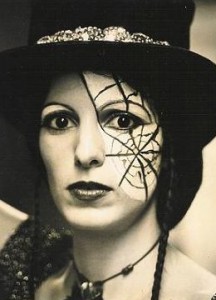 Aside from Bob’s writing collaboration with members of The Band during the Big Pink/Basement Tapes sessions, “Desire” marks his first real foray into co-writing. Dylan composed seven of the LP’s nine songs in partnership with songwriter/theater director Jacques Levy. (Levy’s background as a clinical psychologist must have come in handy when working with a capricious artist like Bob.) Two of the album’s songs stirred controversy. “Hurricane” — about the wrongful imprisonment of Rubin “Hurricane” Carter, a middleweight boxer charged with triple murder in 1966 — was criticized for its inaccuracies and libelous accusations. Yet, it did much to publicize Carter’s case; the conviction was overturned in 1985. “Joey,” an accordion-drenched paean to mafioso “Crazy Joe” Gallo, was viewed as a sappy lionization of a murderer. Still, the album maintained the number one spot on the Billboard Hot 100 for five weeks, beginning on February 7, 1976. For what it’s worth, Rolling Stone lists it as number 6 among Dylan’s best albums, and #174 on its list of The 500 Greatest Albums of All Time.
Aside from Bob’s writing collaboration with members of The Band during the Big Pink/Basement Tapes sessions, “Desire” marks his first real foray into co-writing. Dylan composed seven of the LP’s nine songs in partnership with songwriter/theater director Jacques Levy. (Levy’s background as a clinical psychologist must have come in handy when working with a capricious artist like Bob.) Two of the album’s songs stirred controversy. “Hurricane” — about the wrongful imprisonment of Rubin “Hurricane” Carter, a middleweight boxer charged with triple murder in 1966 — was criticized for its inaccuracies and libelous accusations. Yet, it did much to publicize Carter’s case; the conviction was overturned in 1985. “Joey,” an accordion-drenched paean to mafioso “Crazy Joe” Gallo, was viewed as a sappy lionization of a murderer. Still, the album maintained the number one spot on the Billboard Hot 100 for five weeks, beginning on February 7, 1976. For what it’s worth, Rolling Stone lists it as number 6 among Dylan’s best albums, and #174 on its list of The 500 Greatest Albums of All Time.
And, as for Scarlet Rivera, she went on to tour with Dylan’s carnival-like Rolling Thunder Revue, which featured a roaming band of minstrel rockers that included Joan Baez, Joni Mitchell, Roger McGuinn, Ramblin’ Jack Elliott, Kinky Friedman, T-Bone Burnett and Mick Ronson. She released two solo albums in the 1970s, toured and recorded with such artists as Tracy Chapman, Indigo Girls, Keb’ Mo’ and David Johansen, and played as a soloist with the Duke Ellington Orchestra at Carnegie Hall and the Kennedy Center. And she’s still on the scene – writing, recording and performing a wide range of music, from Celtic and World Music to instrumental New Age. But it’s her work with Dylan, and the serendipitous nature of their initial meeting, that’s the stuff of rock history.
(There. I managed to get through this entire article without once using Dylan’s “Simple Twist of Fate” song title to describe Rivera’s rise to fame.)
Here’s a clip featuring Scarlet’s music. This is a promo for a concert commemorating the 30th anniversary of Dylan’s Rolling Thunder Revue.
© Dana Spiardi, Feb 10, 2013
]]>
So, what song could the defense attorney possibly be citing? It’s 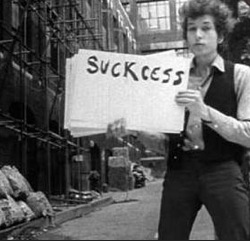 Bob Dylan’s word-twister from 1965, “Subterranean Homesick Blues,” one of the most influential and imitated songs in popular music. With its random satirical lyrics delivered in rapid-fire deadpan style, Bob takes aim at the emerging social strife of the day: civil rights battles (better stay away from those that carry around a fire hose), the burgeoning drug scene (Johnny’s in the basement mixing up the medicine), and authority figures (don’t follow leaders / watch the parking meters.) It’s like a sociopolitical jump rope chant.
Bob Dylan’s word-twister from 1965, “Subterranean Homesick Blues,” one of the most influential and imitated songs in popular music. With its random satirical lyrics delivered in rapid-fire deadpan style, Bob takes aim at the emerging social strife of the day: civil rights battles (better stay away from those that carry around a fire hose), the burgeoning drug scene (Johnny’s in the basement mixing up the medicine), and authority figures (don’t follow leaders / watch the parking meters.) It’s like a sociopolitical jump rope chant.
But the lyric that’s best remembered is: You don’t need a weatherman to know which way the wind blows. And, according to a 2007 study by Alex Long, that line has been quoted by judges, lawyers, and law scholars more than any other lyric from popular music. Mr. Long is a University of Tennessee law professor who spent an entire semester back in 2007 researching the use of popular song lyrics in court findings and legal publications. He found that half a dozen California appellate court rulings have used Dylan’s weatherman line to show that testimony is unnecessary to make a point that would be obvious to any layman.
Bob Dylan’s poetic, often stinging lyrics have long served as a social barometer. In addition to “Subterranean Homesick Blues,” many of his tunes have shown up in legal proceedings and briefs. According to Long, as of 2007, Dylan, lines had been quoted 186 times. Compare this to the lyrics of The Beatles, 74; Bruce Springsteen, 69; Paul Simon, 59; Woody Guthrie, 43; the Rolling Stones, 39; the Grateful Dead, 32; Simon & Garfunkel, 30; Joni Mitchell, 28; and R.E.M., 27.
So, if you ever get hauled before the judge, you’d better hope your lawyer was a ’60s hipster or a modern day Dylan devotee. To paraphrase Bobby: better stay away from those / who Dylan songs they don’t knows.
Below is a short commentary on the making of the famous “Bob in the alley” music video for “Subterranean Homesick Blues.” It’s from D.A. Pennebaker’s Dylan documentary, “Don’t Look Back.” Saint Allen Ginsberg is in the background – on the pavement, thinking about pissing off the government. Bob once said he based the lyrical style of the song on Chuck Berry’s famous scat record “Too Much Monkey Business.“
© Dana Spiardi, May 24, 2014
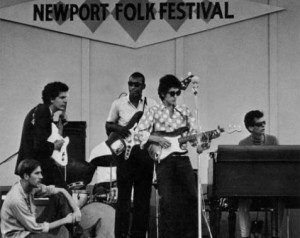 Young Alan Peter Kuperschmidt was scraping by as a Tin Pan Alley songwriter and budding rock musician when his friend, Columbia Records producer Tom Wilson, invited him to sit in on one of the most famous studio sessions of all time: the recording of Dylan’s first fully electric album (and my favorite LP of all time), “Highway 61 Revisited.” Says Kooper in his rollicking memoir, Backstage Passes and Backstabbing Bastards – Memoirs of a Rock-n-Roll Survivor, “In 1965, being invited to a Bob Dylan session was like getting backstage passes to the fourth day of creation.”
Young Alan Peter Kuperschmidt was scraping by as a Tin Pan Alley songwriter and budding rock musician when his friend, Columbia Records producer Tom Wilson, invited him to sit in on one of the most famous studio sessions of all time: the recording of Dylan’s first fully electric album (and my favorite LP of all time), “Highway 61 Revisited.” Says Kooper in his rollicking memoir, Backstage Passes and Backstabbing Bastards – Memoirs of a Rock-n-Roll Survivor, “In 1965, being invited to a Bob Dylan session was like getting backstage passes to the fourth day of creation.”
Still, Kooper was invited to observe, not play. But that didn’t stop the tenacious young man from bringing along his guitar in the hopes of scheming his way into recording history. “There was no way in hell I was going to visit a Bob Dylan session and just sit there pretending to be some reporter from Sing Out! magazine!” he said.
Before Tom Wilson entered the studio, Al had already unpacked, plugged in, and tuned up his guitar. What’s the worst that could happen? If Wilson balked, he’d just say he misunderstood his reason for being invited. Then, in walked a wild-looking character named Mike Bloomfield, Fender Telecaster in hand. His guitar warmups alone were impressive enough to convince the ever-confident Kooper that he was a mere piker in comparison. He sheepishly unplugged his guitar, retreated to the control room, and and sat contritely, “pretending to be a reporter from Sing Out! magazine.”
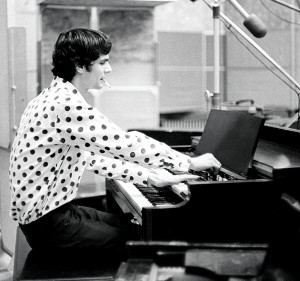 With God-almighty Dylan finally on the scene, a long day’s recording journey into night began, with the creation of a multi-verse narrative song called “Like a Rolling Stone.” Dylan, notorious for constantly changing his mind during sessions, decided that the organ part originally conceived for the song would be better suited to piano. When keyboardist Paul Griffin moved over to piano, Kooper made a last-ditch effort to jump in, begging Tom Wilson for a chance to tinker on the Hammond organ (an instrument he knew nothing about, by the way). Wilson told Kooper he’d only embarrass himself, then left the studio temporarily to tend to other business. Seizing the moment, Al quickly planted himself at the organ, and took the biggest leap of his life.
With God-almighty Dylan finally on the scene, a long day’s recording journey into night began, with the creation of a multi-verse narrative song called “Like a Rolling Stone.” Dylan, notorious for constantly changing his mind during sessions, decided that the organ part originally conceived for the song would be better suited to piano. When keyboardist Paul Griffin moved over to piano, Kooper made a last-ditch effort to jump in, begging Tom Wilson for a chance to tinker on the Hammond organ (an instrument he knew nothing about, by the way). Wilson told Kooper he’d only embarrass himself, then left the studio temporarily to tend to other business. Seizing the moment, Al quickly planted himself at the organ, and took the biggest leap of his life.
He plugged away, hesitantly playing by feel, with no sheet music, direction or acknowledgment. He carefully waited to hear the chords of the other instruments, then came in an eighth note behind his fellow musicians, whose music was so overpowering he could barely hear his own organ playing. When you listen closely to the completed masterpiece, you become aware of the timid naiveté of his playing. His chords are brilliant in their simplicity. During playback of one of the early takes, Dylan asked that the organ part be turned up. Tom Wilson did a head turn, quickly apologizing for Kooper’s antics. But the predictably unpredictable Bob always got his way, and Al’s impromptu performance was to become the stuff that rock legends are made of. Alan Kuperschmidt was now on the path to a long and interesting career.
Blessed with ability, charisma and loads of chutzpah, Kooper is one of rock’s most accomplished figures. He’s toured with Dylan several times, most notably in 1965 during Bob’s controversial all-electric early shows. (Contrary to popular belief, Al claims the folk purists booed Dylan at the 1965 Newport Folk Festival because the set was short and the sound was poor, not because it was electric).
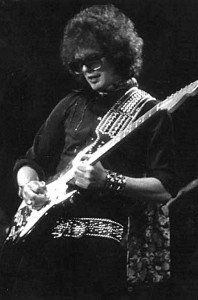 Kopper went on to play keyboards in the psychedelic-blues jam band The Blues Project and founded the rock-blues-brass fusion group Blood, Sweat and Tears. He recorded one of the 1960s’ most respected blues jam albums – “Super Session” – with Mike Bloomfield. He’s released numerous solo LPs and has played everything from keyboards to guitar to French horn in sessions for George Harrison, the Stones, Jimi Hendrix, The Who, Joe Cocker, B.B. King, Alice Cooper, and Tom Petty.
Kopper went on to play keyboards in the psychedelic-blues jam band The Blues Project and founded the rock-blues-brass fusion group Blood, Sweat and Tears. He recorded one of the 1960s’ most respected blues jam albums – “Super Session” – with Mike Bloomfield. He’s released numerous solo LPs and has played everything from keyboards to guitar to French horn in sessions for George Harrison, the Stones, Jimi Hendrix, The Who, Joe Cocker, B.B. King, Alice Cooper, and Tom Petty.
And, he’s produced loads of albums, including Dylan’s “New Morning,” Lynyrd Skynyrd’s first three LPs, and the provocative debut album of bizarro band The Tubes. Along the way he’s found time to score music for Hal Ashby’s film “The Landlord,” John Waters’ movie “Cry Baby,” and Michael Mann’s TV series “Crime Story.” He’s even taught songwriting and record production courses at Berklee College of Music, and once formed a band with fellow professors called The Funky Faculty.
Through sheer ambition and audacity, Al Kooper kick-started his career by contributing a defining sound to the most influential rock song of the 20th century. But even without that lucky break he would never have been a complete unknown, thanks to his innate drive, quick wits, good taste, and sheer talent. His hilarious, must-read memoir, Backstage Passes, is an epic tale of a man who’s not only enjoyed the respect of his peers over the course of five decades, but has managed to survive drugging, personal illness, and the various backstabbing bastards of the sordid music business.
Click below to listen to “Like a Rolling Stone,” and experience the Hammond organ magic that Al brought to the song.
And, here’s Al on keyboards, with his friend, the late, great Mike Bloomfield, performing “Albert’s Shuffle” from their Super Session LP.
Dana Spiardi, Feb 5, 2014
]]>Twelve others great Americans, including Madeleine Albright, John Glenn and Toni Morrison, were also honored with Medals of Freedom today at the White House. Read more.
Here’s President Obama’s introduction to Bob and his music:
Here’s the Prez giving Bob his medal:
© Dana Spiardi, May 29, 2012
]]>